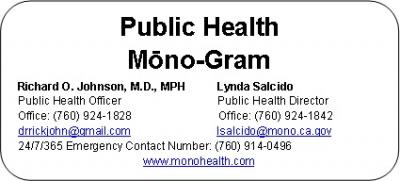Mono-Gram - Smoke, Lightning, and Heat 6/26/15
Smoke, Lightning, and Heat
Below is a summary of key points to keep in mind for the next few days --
Smoke -- with fairly light winds today smoke from the various fires will tend to ooze around in various directions. Degraded air quality is likely in communities throughout the Eastern Sierra. After settling into the valleys at night where concentrated areas of thick smoke are possible, wind projections suggest a slight westward movement though again winds are light so the smoke will tend to move randomly/slowly. Advice -- Communities with outdoor events should have contingencies in case the smoke becomes thick enough to impact health, and monitor statements from Great Basin Unified Air Pollution Control District at: http://www.gbuapcd.org/healthadvisory/
Thunderstorms -- moisture aloft working into the region will lead to buildups Thursday afternoon followed by decent chances for thunderstorms each day Friday through early next week. Confidence is still medium due to uncertainties in how isolated or widespread storms may be.
- Friday/Saturday - fast moving storms over the Sierra and far western Nevada are likely to be dry with potential for new fire starts from lightning, and particularly strong and unpredictable outflow winds. Fire suppression efforts would be impacted by these microbursts.
- Sunday/Monday - we're likely to see a transition to wetter storms with an increased risk of flash flooding. Be aware of your flash flood hot spots and have a plan. Important -- Areas around and downstream of fires are at enhanced risk of seeing flash flooding and debris flows if storms develop overhead Sunday/Monday.
Heat -- confidence remains high in a heat wave impacting the region, with the core of the hottest temperatures Thursday-Saturday, possibly lasting into Sunday for western Nevada. 100-107 in the western Nevada Valleys and 85-90 in the Sierra at Tahoe and Mammoth elevations, which are near or exceeding daily record highs. Advice -- keep an eye on those prone to heat illness. Extra heat precautions should be considered for outdoor events and fire suppression activities Thursday through the weekend. Also - have a thunderstorm/lightning plan...
As temperatures rise over the next few days, we are reminding residents and visitors that heat-related illnesses can be deadly and are urging people to take precautions to avoid them. There are simple steps people can take to keep risk at a minimum.
1. Drink Plenty of Fluids – Even If You Don’t Feel Thirsty
- Increase your fluid intake regardless of your activity level. During heavy exercise in hot weather, drink 2-4 glasses (16-32 ounces) of cool fluids each hour.
2. Stay Cool Indoors
- The most efficient way to beat the heat is to stay in an air conditioned area. If you do not have an air conditioner or evaporative cooling unit, consider a visit to a shopping mall or public library for a few hours.
3. Stay Cool Outdoors
- Plan activities so that you are outdoors either before noon or in the evening. In the hot sun, a wide-brimmed hat will keep the head cool. While outdoors, rest frequently in a shady area.
4. Monitor Those at High Risk
- If you are 65 years of age or older, have a friend or relative call to check on you twice a day during a heat wave. If you know anyone in this age group, check on them at least twice a day. When working in the heat, monitor the condition of your coworkers and have someone do the same for you.
5. Pace Yourself
- If you are unaccustomed to working or exercising in hot weather, start slowly and pick up the pace gradually. If exertion in the heat makes your heart pound and leaves you gasping for breath, stop all activity, get into a cool or shady area, and rest, especially if you become lightheaded, confused, weak, or feel faint.
6. Use Common Sense
- Do not leave infants, children, or pets in a parked car. Bring your pets indoors with you to protect them. Give your outdoor animals plenty of fresh water, leave the water in a shady area, and consider wetting the animal down. Those at highest risk of heat-related illness are the very young, the elderly, and those who must work outdoors in extremely high temperatures. Sudden rise in body temperature and dehydration can lead to heat stroke or heat exhaustion. If not addressed quickly, brain damage or death can result. “High temperatures like those we expect in the next few days and throughout the summer can have serious health consequences.” People can avoid lots of problems if they just use a little common sense such as: never leaving infants, children or pets in a parked car, as temperatures can soar rapidly and cause severe brain injury or even death; drinking plenty of fluids that don’t contain caffeine or alcohol (these cause dehydration); staying indoors preferably in an air-conditioned environment such as libraries, stores, or restaurants; and, limiting strenuous activities between noon to 6 p.m., when temperatures tend to be highest.
Heat-related information can also be found from the Centers for Disease Control and Prevention at: http://emergency.cdc.gov/disasters/extremeheat/heattips.asp
Information about pet safety and heat can be found at: http://www.washoecounty.us/outreach/2015/04/2015-04-27-pets.php


